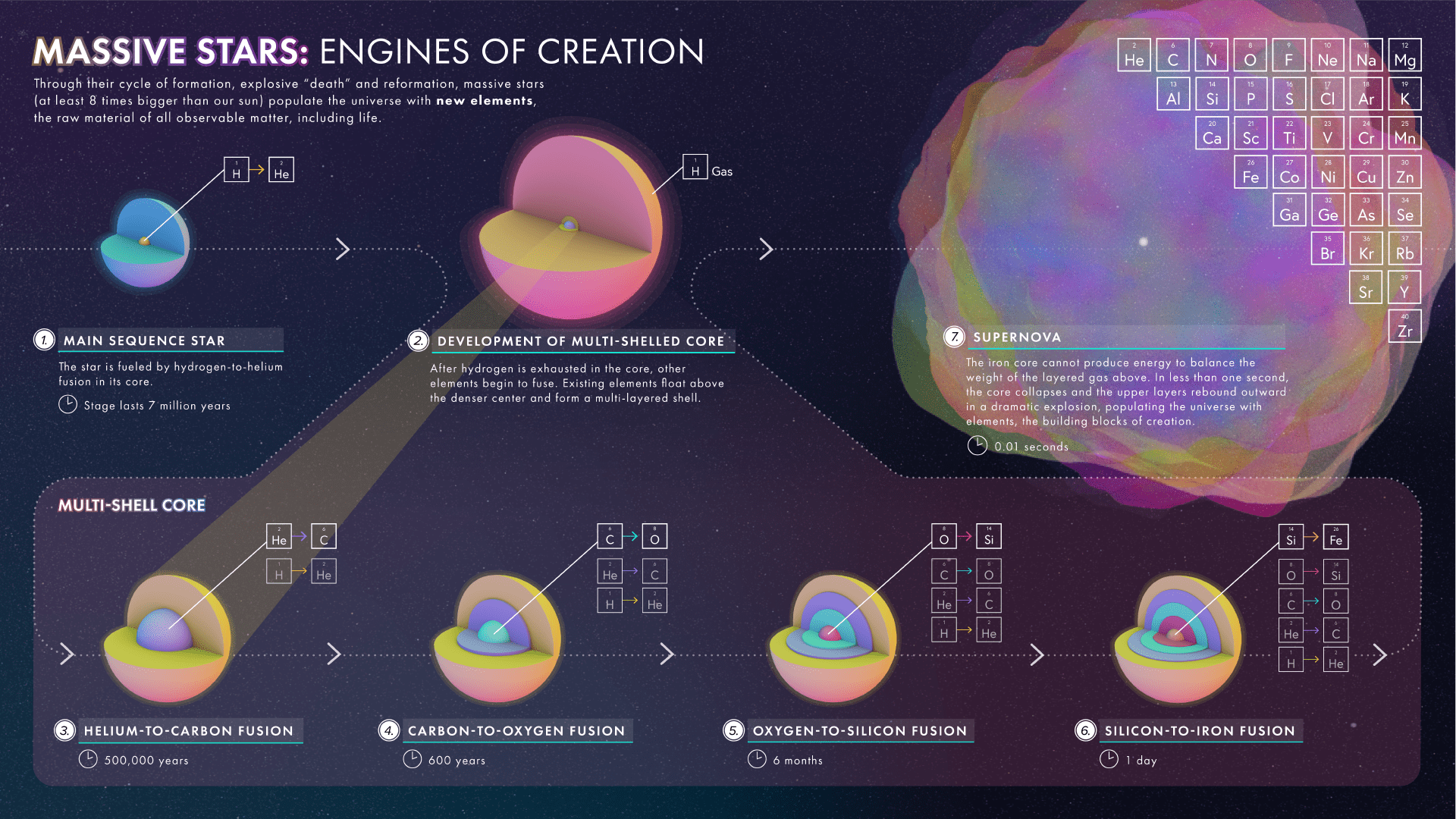In February 1987, light from an exploding star arrived at Earth after traveling across 160,000 light-years of space. It was the closest supernova humanity had seen in centuries. Thirty-two years later, the light of the supernova itself has faded, but astronomers continue to study its remains for clues about how stars live and die. Scientists will use NASA’s James Webb Space Telescope to observe Supernova 1987A (SN 1987A), as it is known, in order to gain new insights into the physics of the explosion and its aftermath.

When you look at a photo of SN 1987A, two features stand out: a clumpy outer ring that looks like a pearl necklace, and an inner blob. The outer ring is material that the star shed thousands of years ago. When the supernova’s blast wave hit this ring, it caused the previously invisible material to heat up and glow. The inner blob is material ejected when the star exploded.
That ejected material revealed a surprise when astronomers observed it with the European Space Agency’s infrared Herschel Space Observatory. They found that it contained an entire sun’s worth of cold dust. More recently, NASA’s SOFIA (Stratospheric Observatory for Infrared Astronomy) mission studied the ring and detected 10 times more dust than expected, indicating a growing amount of dust there, too.
Theories suggest that any dust within the ring that predated the explosion should have been destroyed by the blast wave, and the ejecta itself should be too hot for new dust to form. As a result, there should be little dust within SN 1987A. Yet observations tell a different story.
“Something has produced dust there. We need Webb to answer questions like, how was the dust produced, and what is it made of?” said lead researcher Margaret Meixner of the Space Telescope Science Institute and Johns Hopkins University, both in Baltimore, Maryland.
What is dust, and why is it important?
Credit: NASA, ESA, and L. Hustak (STScI)
Cosmic dust is different from the dust bunnies that you find under your furniture. It’s smaller, mainly consisting of micron-sized particles like those in smoke. And rather than being made of bits of hair or clothing fibers, cosmic dust is composed of a variety of chemical elements like carbon, silicon and iron all stuck together. As a result, measuring the composition of a particular patch of cosmic dust is challenging because the signatures of the elements blend together.
“We have no clue what the dust in Supernova 1987A is made of – whether it’s rocky and silicate-rich, or sooty and carbon-rich. Webb will let us learn not only the composition of the dust, but its temperature and density,” explained Olivia Jones of the United Kingdom Astronomy Technology Centre, a co-investigator on the project.
As dust from dying stars spreads through space, it carries essential elements to help seed the next generation of star and planet formation. “Dust is what the planets are made out of, what we’re made out of. Without dust, you have no planets,” said Jones.
Dust also is important for the evolution of galaxies. Observations have shown that distant, young galaxies had lots of dust. Those galaxies weren’t old enough for sun-like stars to create so much dust, since sun-like stars last for billions of years. Only more massive, short-lived stars could have died soon enough and in large enough numbers to create the vast quantities of dust astronomers see in the early universe.
The birth of a supernova remnant
The team plans to examine SN 1987A with two of Webb’s instruments: the Mid-Infrared Imager (MIRI) and the Near-Infrared Spectrograph (NIRSpec). With imaging, Webb will reveal features of SN 1987A far beyond any previous infrared observations due to its exquisite resolution. Astronomers expect to be able to map the temperature of the dust within both the supernova ejecta and the surrounding ring. They can also study the interaction of the blast wave with the ring in great detail.

Webb’s true power will come from its spectroscopic measurements. By spreading light out into a rainbow spectrum of colors, scientists can determine not only chemical compositions but also temperatures, densities, and speeds. They can examine the physics of the blast wave, and determine how it is affecting the surrounding environment. They can also watch the evolution of the ejected material and ring over time.
“We’re witnessing the birth of a supernova remnant,” said Patrice Bouchet of DRF/Irfu/Astrophysics Department, CEA-Saclay in France, a co-principal investigator for the MIRI European Consortium. “This is a once-in-a-lifetime event.”
“Supernova 1987A is an object that continually surprises people,” said Meixner. “This is one you’ll want to keep your eyes open for!”
The observations described here will be taken as part of Webb’s Guaranteed Time Observation (GTO) program. The GTO program provides dedicated time to the scientists who have worked with NASA to craft the science and instrument capabilities of Webb throughout its development.
The James Webb Space Telescope will be the world’s premier space science observatory when it launches in 2021. Webb will solve mysteries of our solar system, look beyond to distant worlds around other stars, and probe the mysterious structures and origins of our universe and our place in it. Webb is an international project led by NASA with its partners, the European Space Agency (ESA) and the Canadian Space Agency.
For more information about Webb, visit www.nasa.gov/webb.
By Christine Pulliam
Space Telescope Science Institute, Baltimore, Md.

























